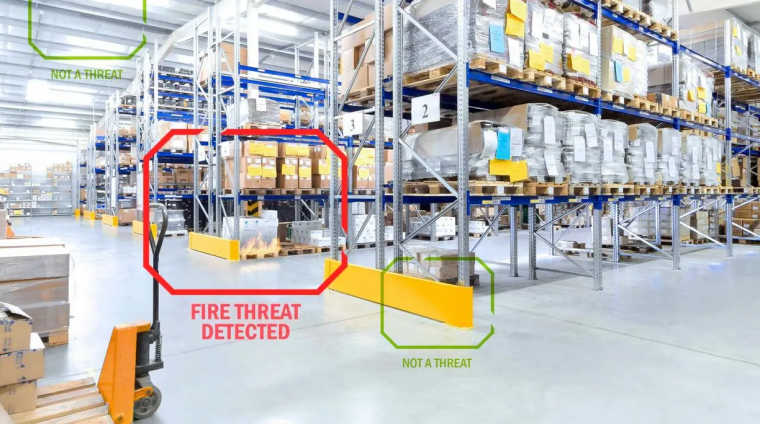Six Challenges for Fire Safety in Warehouses
Swift recognition of flames and smoke is vital to keep warehouses and depots protected from fire. An intelligent video-based fire detection solution monitors stock around the clock.

Some challenges to fire safety are unique to warehouses and logistics depots:
- Kindling materials as packaging
- Shelf stocks change frequently and materials inside the package can be flammable: textiles, alcohol, battery-powered items etc.
- Risk of collision between machinery or shelving: potential to ignite or combust
- Smoke Detection is difficult due to high ceilings
- Sprinkler systems damage goods when activated
- Outdoor storage even more vulnerable
1. Packaging often comprises paper and cardboard, plus adhesives. Together they can make the perfect kindling material. Especially when sources of heat, for instance, sunlight or electrical equipment, come into contact with them.
2. Stock on the shelves, especially for parcel delivery services or online shops, can change frequently – and this means the items contained within them also change. Anything inside a package, from flammable textiles like polyester to perfumes containing alcohol, or battery-operated toys, might seem harmless as single items, but if a fire were to break out, each would accelerate the spread of flames. It’s hard for safety managers to keep an eye on what’s exactly stored on site, and therefore the precise fire risk, at any one time.
3. A logistics depot or warehouse is a buzzing hive of activity: Goods in, goods out; forklift trucks or robots are in constant movement on the floor to pick up items or place them on shelves. This creates risks of collisions between machinery or with shelving, with the potential to ignite or combust. Items on higher shelves could also fall on impact. Not only does this put personnel in danger, but business continuity could be halted within minutes of a fire taking hold in a building full of goods that customers are waiting for.
4. High ceilings in warehouses make smoke detection difficult using classic fire detectors – they rely on smoke reaching to where they are installed. If a fire breaks out on the floor or lower shelving, the devastation could occur well before any alarms sound.
5. Sprinkler systems are often installed in spacious areas, but, although they protect the exterior building, valuable assets under its roof could become water-damaged and deemed unfit for purpose or delivery.
Outdoor Storage Even more Challenging: Arson, Vandalism, Wind Tunnels
6. Outdoor storage shelters used as an extension of main buildings are even more challenging. They are constantly vulnerable to arson and vandalism, plus their open structure makes smoke detectors unusable. Wind tunnels created by high-stacked shelves with gaps in-between intensify this issue further. In addition, materials stored outside could be flammable or combustible. Delivery vehicles, full of fuel and ready to transport goods, are often parked on the premises, creating further hazards. Yet an outdoor area is often not protected against fire at all. Security cameras might be installed to monitor criminal activity but not fires, and they often produce grainy visuals at night.
A more sophisticated and reliable system is needed to swiftly detect flames or smoke, in both daylight and darkness:














